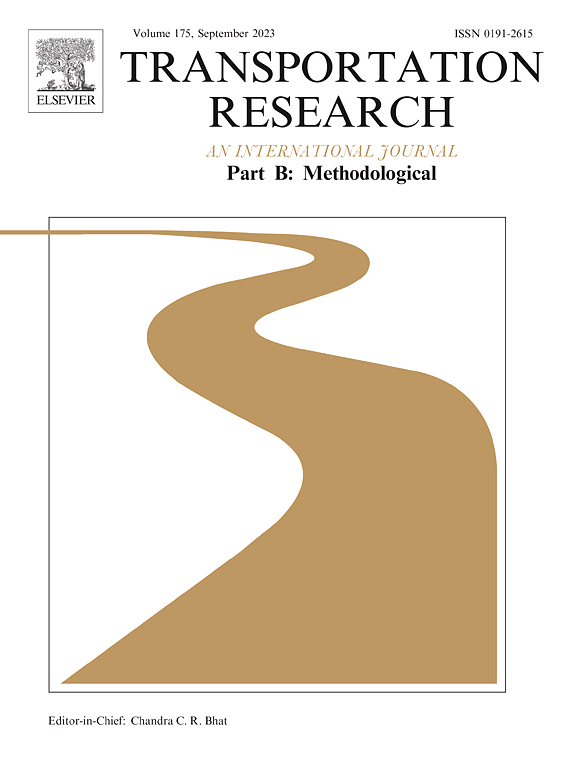On the morning commute problem with mixed autonomous and human-driven traffic under stochastic bottleneck capacity
IF 6.3
1区 工程技术
Q1 ECONOMICS
引用次数: 0
Abstract
This paper investigates the impact of external uncertainty on morning commute behavior when autonomous vehicles (AVs) are introduced and interact with human-driven vehicles (HVs). We adopt the bottleneck model to study the morning commuting dynamics. In this context, we consider two potential benefits for AVs, i.e., value-of-time (VOT) compensation/reduction and capacity enhancement. We develop an extension-elimination-verification-supplement approach to simplify the equilibrium analysis process to obtain the equilibrium departure flow patterns. We find that the external uncertainty makes the equilibrium departure flow patterns more complicated than those under the deterministic setting, yielding three basic departure flow pattern types, i.e., AVs travel inside HVs, AVs travel after HVs, and HVs and AVs depart alternatively. If AVs are able to reduce VOT, their ability to improve bottleneck capacity does not qualitatively change the equilibrium departure flow patterns. Moreover, although increasing the penetration of AVs can improve the system performance to some degree, the total travel costs may not be monotonically decreasing with respect to AV penetration when AVs cannot significantly enhance bottleneck capacity. The optimal penetration rate of AVs minimizing the total travel costs is no less than 50% and the total travel costs reach the minimum in the situation with mixed HVs and AVs rather than in the 100% AV penetration if the bottleneck capacity enhancement caused by AVs is not significant enough. Furthermore, increasing the penetration of AVs may indeed increase traffic congestion when compared to that under 100% HVs if AVs cannot enhance bottleneck capacity sufficiently. To reduce total travel costs by increasing AV penetration, it is necessary to ensure that AVs can enhance bottleneck capacity sufficiently as the penetration rate of AVs increases when the adverse effects of VOT compensation on traffic congestion are dominated. When the penetration rate of AVs reaches 100%, the capacity enhancement from AVs should be sufficiently large to ensure that AVs can simultaneously improve the system performance and reduce traffic congestion.
随机瓶颈容量下自主与人为混合交通的早晨通勤问题
本文研究了引入自动驾驶汽车(av)并与人类驾驶汽车(HVs)交互时,外部不确定性对早晨通勤行为的影响。我们采用瓶颈模型来研究早晨通勤动态。在这种情况下,我们考虑了自动驾驶汽车的两个潜在好处,即时间价值(VOT)补偿/减少和容量增强。提出了一种扩展-消除-验证-补充的方法,简化了平衡分析过程,得到了平衡偏离流模式。研究发现,外部不确定性使得均衡出发流模式比确定性设置下更加复杂,产生了三种基本的出发流模式类型,即自动驾驶汽车在车辆内行驶、自动驾驶汽车在车辆后行驶、车辆与自动驾驶汽车相互替代。如果自动驾驶汽车能够降低VOT,其提高瓶颈容量的能力并不会从本质上改变均衡离港流模式。此外,虽然增加自动驾驶汽车的普及率可以在一定程度上提高系统性能,但当自动驾驶汽车不能显著提高瓶颈容量时,总出行成本可能不会随着自动驾驶汽车的普及率而单调下降。在总出行成本最小的情况下,自动驾驶汽车的最优渗透率不小于50%,当自动驾驶汽车带来的瓶颈容量提升不够显著时,自动驾驶汽车的总出行成本在混合情况下达到最小,而在自动驾驶汽车100%渗透率时达到最小。此外,如果自动驾驶汽车不能充分增强瓶颈容量,与100% HVs下相比,增加自动驾驶汽车的渗透率确实会增加交通拥堵。为了通过提高自动驾驶汽车普及率来降低总出行成本,在VOT补偿对交通拥堵的不利影响占主导地位的情况下,必须保证随着自动驾驶汽车普及率的提高,自动驾驶汽车能够充分增强瓶颈容量。当自动驾驶汽车的渗透率达到100%时,自动驾驶汽车带来的容量提升应该足够大,以保证自动驾驶汽车能够同时提升系统性能和减少交通拥堵。
本文章由计算机程序翻译,如有差异,请以英文原文为准。
求助全文
约1分钟内获得全文
求助全文
来源期刊
CiteScore
12.40
自引率
8.80%
发文量
143
审稿时长
14.1 weeks
期刊介绍:
Transportation Research: Part B publishes papers on all methodological aspects of the subject, particularly those that require mathematical analysis. The general theme of the journal is the development and solution of problems that are adequately motivated to deal with important aspects of the design and/or analysis of transportation systems. Areas covered include: traffic flow; design and analysis of transportation networks; control and scheduling; optimization; queuing theory; logistics; supply chains; development and application of statistical, econometric and mathematical models to address transportation problems; cost models; pricing and/or investment; traveler or shipper behavior; cost-benefit methodologies.

 求助内容:
求助内容: 应助结果提醒方式:
应助结果提醒方式:


